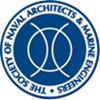用阻力模拟模拟器从模型试验中预测船体阻力
IF 1
4区 工程技术
Q3 ENGINEERING, CIVIL
引用次数: 0
摘要
根据模型尺寸和试验速度,模型雷诺数通常比满标度下的雷诺数少一到两个数量级。模型表面上的层流区域明显大于全尺寸下的层流区域。湍流激励器(TS)广泛应用于模型阻力试验,以模拟船舶边界层流动。由于缺乏理论指导,每个测试设施中使用的湍流刺激器的尺寸、形状和位置通常是根据每个实验室获得的经验进行选择的,并且在一些测试设施中,从测量的模型阻力中减去TS引起的寄生阻力,而在其他设施中则不减去。如果湍流刺激可以指定为实现模型和全尺寸之间的动量厚度相似性,则形状因子将是恒定的,因此可以应用一个简单的比例公式来预测船舶阻力。应用这个简单的比例公式,可以从测量的模型阻力中预测船舶阻力。本文描述了对于给定的船体几何形状、船舶雷诺数和模型雷诺数,如何根据本文推导的三个方程设计出独特的TS(尺寸、形状和位置)。这种独特设计的TS在本文中被称为“阻力相似模拟器”。模拟器引起的寄生阻力是相似性解决方案的一部分,不需要从测量的模型阻力中减去。1.引言预测阻力的能力在船舶或潜艇的设计中起着重要作用。推进器设计和确定所需功率需要对船舶阻力进行准确预测。容器的阻力也强烈影响其寿命操作成本。尽管现在通常使用计算方法来估计船舶阻力,但仍然严重依赖模型试验,并且使用比例公式来将模型数据与全尺寸性能联系起来。本文章由计算机程序翻译,如有差异,请以英文原文为准。
Ship Hull Resistance Prediction from Model Tests with a Resistance Similitude Simulator
Depending on model sizes and test speeds, model Reynolds numbers are typically one to two orders of magnitude less than those occurring at full scale. The region of laminar flow is significantly larger on a model surface than at full scale. Turbulence stimulators (TSs) are extensively applied in model resistance tests to simulate ship boundary layer flow. Because of lack of theoretical guidance, the size, shape, and location of turbulent stimulators used in each test facility are typically selected based on experience gained in each laboratory, and parasitic drag induced by TSs is subtracted from measured model resistance in some test facilities and not subtracted in other facilities. If turbulence stimulation can be specified in such a way as to achieve momentum thickness similarity between the model and full scale, the form factor will be constant, so a simple scaling formula can be applied to predict ship resistance. Ship resistance can be predicted from measured model resistance with the application of this simple scaling formula. The article describes how for a given body geometry, ship Reynolds number and model Reynolds number, a unique TS (size, shape, and location) can be designed based on three equations derived in this article. This uniquely designed TS is termed the "resistance similitude simulator" in this article. The parasitic drag induced by the simulator is a part of the similarity solution and does not need to be subtracted from measured model resistance.
1. Introduction
The ability to predict resistance plays an important role in the design of a ship or submarine. An accurate prediction of the drag of the vessel is required for the propulsor design and to determine the required power. The resistance of the vessel also strongly influences its lifetime operation costs. Although computational methods are now commonly used to estimate ship resistance, model tests are still heavily relied on, and scaling formulae are used to relate model data to full-scale performance.
求助全文
通过发布文献求助,成功后即可免费获取论文全文。
去求助
来源期刊

Journal of Ship Research
工程技术-工程:海洋
CiteScore
2.80
自引率
0.00%
发文量
12
审稿时长
6 months
期刊介绍:
Original and Timely technical papers addressing problems of shipyard techniques and production of merchant and naval ships appear in this quarterly publication. Since its inception, the Journal of Ship Production and Design (formerly the Journal of Ship Production) has been a forum for peer-reviewed, professionally edited papers from academic and industry sources. As such, it has influenced the worldwide development of ship production engineering as a fully qualified professional discipline. The expanded scope seeks papers in additional areas, specifically ship design, including design for production, plus other marine technology topics, such as ship operations, shipping economic, and safety. Each issue contains a well-rounded selection of technical papers relevant to marine professionals.
 求助内容:
求助内容: 应助结果提醒方式:
应助结果提醒方式:


